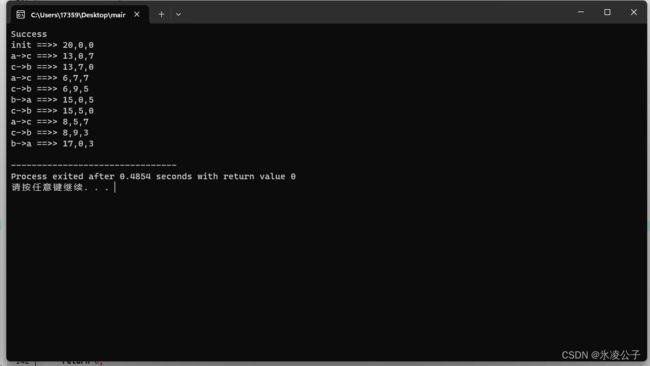分油问题C++求解
原题
3个油桶,容量分别为(大桶)20,(中桶)9,(小桶)7,初始时大桶满油,如何操作可以分出17的油?
代码
#include
#include
#include
#include
using namespace std;
class R {
public:
int l,v;
};
class T {
public:
R a,b,c;
int last;
string xw;
T(R a,R b,R c):a(a),b(b),c(c) {
}
T(R a,R b,R c,int last,string xw):a(a),b(b),c(c),last(last),xw(xw) {
}
int id() {
return a.v*100+b.v*10+c.v;
}
};
void go(R *r1,R *r2) {
int v=r2->v+r1->v;
v=min(v,r2->l);
int cha=v-r2->v;
r2->v=v;
r1->v-=cha;
}
void dfs(vector vt,T t) {
if(t.last==-1){
cout<> "<> "< s;
queue q;
q.push(t);
s.insert(t.id());
vector vt;
while(!q.empty()) {
t=q.front();
q.pop();
if(t.a.v==targetV || t.b.v==targetV || t.c.v==targetV) {
cout<<"Success"<0) {
if(b.vb");
go(&(temp.a),&(temp.b));
int id=temp.id();
if(s.find(id)==s.end()) {
q.push(temp);
s.insert(id);
}
}
if(c.vc");
go(&(temp.a),&(temp.c));
int id=temp.id();
if(s.find(id)==s.end()) {
q.push(temp);
s.insert(id);
}
}
}
if(b.v>0) {
if(a.va");
go(&(temp.b),&(temp.a));
int id=temp.id();
if(s.find(id)==s.end()) {
q.push(temp);
s.insert(id);
}
}
if(c.vc");
go(&(temp.b),&(temp.c));
int id=temp.id();
if(s.find(id)==s.end()) {
q.push(temp);
s.insert(id);
}
}
}
if(c.v>0) {
if(a.va");
go(&(temp.c),&(temp.a));
int id=temp.id();
if(s.find(id)==s.end()) {
q.push(temp);
s.insert(id);
}
}
if(b.vb");
go(&(temp.c),&(temp.b));
int id=temp.id();
if(s.find(id)==s.end()) {
q.push(temp);
s.insert(id);
}
}
}
}
return 0;
} 运行
解析
1.每个桶有它的容量以及目前油量,数据结构定义为
class R {
public:
int l,v;
};表示容量和油量
2.每次操作可以从一个非空桶尽可能倒油到另一个非满桶【因为倒到满桶没有意义】,这个一定要理解,倒油实现函数为
void go(R *r1,R *r2) {
int v=r2->v+r1->v;
v=min(v,r2->l);
int cha=v-r2->v;
r2->v=v;
r1->v-=cha;
}因为被倒入的桶容量有限,所以要做个较小值判断
3.每完成一次倒油操作,做一次记录,记录下当前3个油桶的油量,以及这个操作【从哪个桶倒入另一个桶的】,数据结构定义为
class T {
public:
R a,b,c;
int last;
string xw;
T(R a,R b,R c):a(a),b(b),c(c) {
}
T(R a,R b,R c,int last,string xw):a(a),b(b),c(c),last(last),xw(xw) {
}
int id() {
return a.v*100+b.v*10+c.v;
}
};其中我们求解出结果之后需要将这些操作都打印出来,所以需要一个列表来存储我们的步骤
vector vt; 那么T.last这个属性就是上一步操作在列表中的下标,方便查找
T.xw表示上一步操作的行为,若T.xw=="a->b",则表示油从a桶倒入b桶。
4.开一个队列来模拟倒油过程,直到有一个操作满足我们的需求,打印倒油过程并退出。
5.有可能没有方案做得到,所以我们需要对每次的方案做标识,避免重复的局面入队,比如:我刚将大桶的油倒入小桶,此时从[20,0,0]=>[13,0,7],紧接着又把油从小桶倒回大桶,这种情况我们需要排除掉,其中T.id这个函数就是表示状态的标识,只要三个桶的油量出现过这种状况,就表示已经做过类似的操作了,此时这个操作就不要入队了。
